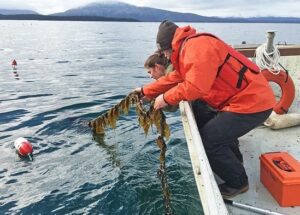
The National Oceanic and Atmospheric Administration on June 1 named Alaska as the third region nationwide for identifying areas for sustainable aquaculture development within coastal and marine waters.
These areas will be selected through engagement with tribes and the public, a process that allows constituents to share their community, tribal and stewardship goals for such development.
Alaska joins Southern California and the Gulf of Mexico in the Aquaculture Opportunity Areas (AOA) program through the multi-year partnership process involving NOAA.
During a previous comment period, NOAA received public support for aquaculture from Alaska Native organizations, the Alaska Department of Fish and Game, the state of Alaska, the Alaska Legislature and industry and research institutions.
With more coastline than all of the Lower 48 states combined, Alaska is uniquely positioned to benefit from a growing marine aquaculture industry, NOAA Fisheries Assistant Administrator Janet Coit said.
Identification efforts use the best available science, indigenous knowledge and collaboration with local communities to foster shellfish and seaweed aquaculture, benefiting Alaska’s Blue Economy, Coit said.
In 2022, aquaculture production sales in Alaska totaled $1.9 million, and the state is experiencing an increase in aquaculture permit applications, NOAA officials said. Aquaculture in AOAs support environmental, economic and social sustainability.
The identification process for AOAs focuses on Alaska state waters and does not include federal waters. NOAA has said that it would only consider marine invertebrates – like shellfish and sea cucumbers – and seaweed farming when identifying AOAs in Alaska. Finfish farming in Alaska state waters is prohibited by law.
Alaska will serve as a partner with NOAA in the design and identification of appropriate locations for AOAs and commercial aquaculture. Identification of these areas is also to be shaped through a public process with opportunities for public comment.
NOAA’s National Centers for Coastal Ocean Science is to provide support for AOA planning in Alaska through ecosystem modeling to help determine the best size and location for AOAs.
Identifying AOAs is helpful for prospective aquaculture growers to consider site selection and environmental analysis, but does not serve as a preapproval in the process. Prospective aquaculture growers still would have to go through comprehensive state and federal permitting processes.
